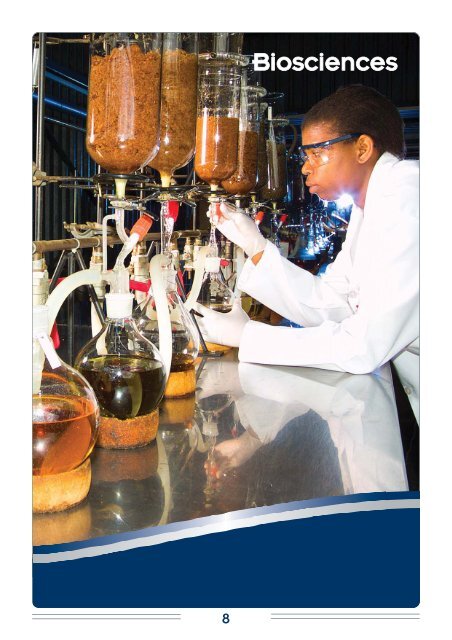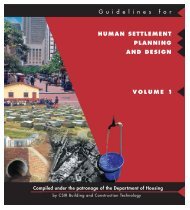Biosciences - CSIR
Biosciences - CSIR
Biosciences - CSIR
Create successful ePaper yourself
Turn your PDF publications into a flip-book with our unique Google optimized e-Paper software.
8<br />
<strong>Biosciences</strong>
Strategic overview<br />
The vision of <strong>CSIR</strong> <strong>Biosciences</strong> is to provide<br />
bioscience solutions that improve health and<br />
fight disease, and that support the private and<br />
public sector industries in a manner that is<br />
sensitive to the economic realities and the<br />
natural environment of the societies we live in.<br />
The strategic objectives that will underpin<br />
achievement of this goal include engagement<br />
and partnership with key stakeholders in the<br />
national R&D system and the National System<br />
of Innovation in order to find alignment with<br />
national imperatives.<br />
The biosciences research core has been<br />
structured into seven platforms, which<br />
incorporate multi-disciplinary expertise required<br />
to deliver on key elements of a research value<br />
chain that is focused on addressing economic<br />
development and health-based socio-economic<br />
challenges: discovery biology, discovery<br />
chemistry, bioprospecting and analytical<br />
platforms focus on the identification and<br />
development of new molecules and biological<br />
targets that find application to provide novel<br />
solutions for HIV, tuberculosis and malaria. The<br />
plant biotechnology, bioprocess technologies<br />
and product and process development<br />
platforms focus on the identification and<br />
development of novel technologies that<br />
enhance the competitiveness of the emerging<br />
South African biosciences industry.<br />
Close interaction with the International<br />
Cooperation and Resources and the Frontier<br />
Science and Technology programmes of the<br />
Department of Science and Technology (DST)<br />
has enabled the organisation to align with<br />
strategies at national level. In this respect,<br />
several strategic initiatives are being<br />
developed. Strong partnerships and<br />
collaborations with local universities and<br />
research councils have been formed, as well as<br />
with top institutions in Africa, Europe and the<br />
US. These partnerships have facilitated access<br />
to world-class laboratories and technologies. In<br />
line with the emphasis on scientific research,<br />
the unit has lodged eight Patent Cooperation<br />
Treaty (PCT) patents during the year that<br />
protect multi-application technologies and will<br />
eventually lead to high-impact publications.<br />
Human capacity to increase the <strong>CSIR</strong> skills<br />
profile is being developed through studentship<br />
and postdoctoral programmes.<br />
9
Mosquito repellent candle factory<br />
launched in Limpopo<br />
<strong>CSIR</strong> researchers and traditional healers who<br />
collaborated in studies on indigenous plants<br />
with mosquito repellent properties, celebrated<br />
the discovery in the mid-1990s of a novel<br />
mosquito repellent that proved to be more<br />
effective than similar or comparable<br />
commercial products on the market.<br />
In August 2005, this discovery resulted in<br />
another celebration when the Deputy Minister<br />
of Science and Technology, Derek Hanekom,<br />
officially launched a community-owned<br />
mosquito repellent candle factory in Limpopo,<br />
where this plant is being cultivated and<br />
distilled, and its essential oils used in the<br />
manufacturing of candles.<br />
Hi-Hanyile is the result of a project aimed at<br />
transferring <strong>CSIR</strong> essential oil production<br />
technology and skills to the Giyani community<br />
in Limpopo, with the DST providing the funding.<br />
The first stages of the project involved the<br />
establishment of a 30 ha cultivation site where<br />
lemon grass and the mosquito repellent<br />
essential oil crop, BP1, are grown and then<br />
processed in an essential oil distillation factory.<br />
The 650 m 2 factory contains equipment<br />
required to formulate the active ingredients of<br />
the candles, as well as to undertake<br />
manufacturing and packaging of 400 000<br />
candles per year.<br />
The project currently provides employment for<br />
67 people from rural communities around<br />
Giyani.<br />
Exploiting proteins to build<br />
molecular motors<br />
Proteins provide the functional scaffolding<br />
constituting all organisms, and enable complex<br />
chemical reactions (using enzymes) that can<br />
convert thousands of substrate molecules per<br />
second.<br />
Proteins are highly organised, forming efficient<br />
and stable nano- to micro-sized protein<br />
complexes. Determining the stability of the<br />
complexes gives insight into how these proteins<br />
are able to fold and interact in the cell,<br />
performing reactions that are not possible in a<br />
chemistry laboratory. <strong>CSIR</strong> researchers,<br />
Dr Neeresh Rohitlall (<strong>CSIR</strong> <strong>Biosciences</strong>) and<br />
Dr Raymond Sparrow (<strong>CSIR</strong> National Laser<br />
Centre), are exploiting these protein<br />
characteristics to build nanomotors — molecular<br />
devices which convert energy into movement<br />
and forces in the order of picoNewtons.<br />
Light has the potential to activate and control<br />
nano-machines that can kill cancer cells, or<br />
even help break up clots in blood vessels and<br />
the brain. Scientists hope to create nanomotors<br />
with applications that can target disease and<br />
repair damaged cells in the body. The <strong>CSIR</strong>’s<br />
molecular motor project is aimed at<br />
engineering a light-activated controllable power<br />
source that can be coupled to a variety of<br />
nanodevices. The proposed nanoscopic energy<br />
source is probably the smallest and most<br />
efficient known energy source. It is the only<br />
such power supply to introduce on/off<br />
controllability as fundamental to its design. The<br />
nanodevice can be developed for specific<br />
applications such as drug delivery, nanoengineering<br />
or minimally invasive nano-surgery,<br />
particularly for delicate tissues such as the<br />
retina.<br />
10
Enzymes put to work to produce<br />
pectin from citrus waste<br />
<strong>CSIR</strong> biochemists are collaborating with the<br />
University of KwaZulu-Natal in Durban, the<br />
Chemin Incubator and Kat River Citrus Co-op<br />
Ltd to establish a pectin production plant that<br />
uses enzymes to produce pectins from citrus<br />
waste.<br />
South Africa’s citrus industry, one of the<br />
biggest exporters worldwide, produces large<br />
volumes of citrus peel waste. Pectin, a<br />
polysaccharide, is found abundantly in the<br />
primary walls and intercellular layers of plant<br />
cells. It is obtained from a variety of sources<br />
including many fruit pulps like orange and<br />
apple pulp.<br />
In citrus fruit, pectin constitutes the white<br />
spongy inner part of the peel. Pectin is<br />
traditionally produced by chemical hydrolysis,<br />
with significant yield losses and the production<br />
of substantial waste streams.<br />
The aim of the three-year project is to extract<br />
and convert high-methodoxyl (HM) pectin from<br />
the citrus peel, to value-added low-methodoxyl<br />
(LM) pectin using an enzyme-based process.<br />
There has recently been significant growth in<br />
the uses of LM pectin. LM pectins are used as<br />
thickening or gelling agents in a broad range<br />
of formulated foods such as yoghurt, milk<br />
desserts and jellies. The <strong>CSIR</strong> will apply its skills<br />
in process chemistry, biotechnology, chemical<br />
engineering and food science to develop the<br />
technology required for the extraction,<br />
hydrolysis, purification and formulation of LM<br />
pectin.<br />
11
The birth of the “safe egg”<br />
Food safety coupled with rising consumer<br />
concerns inspired the establishment of an R&D<br />
consortium led by the <strong>CSIR</strong>. The consortium<br />
successfully developed a new system to<br />
pasteurise shell eggs, significantly reducing the<br />
risk of Salmonella enteritidis, a disease-causing<br />
micro-organism carried by infected chicks.<br />
Uncooked and semi-cooked eggs and products<br />
containing raw eggs – many types of desserts,<br />
mayonnaise and salad dressings – can contain<br />
the pathogen resulting in salmonella poisoning.<br />
The consortium, supported financially by South<br />
Africa’s Innovation Fund, draws together the<br />
expertise of food scientists and microbiologists<br />
at the <strong>CSIR</strong>, sensory evaluation experts at the<br />
University of Pretoria, design engineering<br />
expertise from Delphius Technologies and<br />
commercial experts at Eggbert Eggs, South<br />
Africa’s second largest egg producer.<br />
The new system involves a specially designed<br />
oven and phased process – which is a<br />
combination of microwave and hot air<br />
technology. The challenge is to keep the eggs<br />
at an optimal temperature to destroy the microorganism<br />
without changing the composition or<br />
taste of the egg.<br />
Preliminary results show that the new<br />
technology also destroys the avian influenza<br />
pathogen. The consortium is in discussion with<br />
local retailers, caterers and restaurants to<br />
consider using and selling pasteurised eggs.<br />
12
Partnership to develop<br />
“super sorghum” for Africa<br />
The <strong>CSIR</strong> has joined forces with eight other<br />
globally-respected organisations to develop<br />
more nutritious, easily digestible sorghum with<br />
increased levels of pro-vitamin A and E, iron,<br />
zinc, essential amino acids and protein<br />
prototype with increased lysine.<br />
An African-led consortium under the leadership<br />
of Kenya-based Africa Harvest Biotech<br />
Foundation International is presently conducting<br />
research into fortifying one of Africa’s<br />
important staple foods. While the grain is<br />
uniquely adapted to the semi-arid and subtropical<br />
climatic conditions of the continent, its<br />
nutritional imbalance can, however result in a<br />
form of hunger known as micronutrient<br />
malnutrition.<br />
The African Biofortified Sorghum Project, a<br />
Grand Challenges in Global Health initiative, is<br />
funded by the Bill and Melinda Gates<br />
Foundation to the tune of US $17.6m. <strong>CSIR</strong><br />
biotechnologists, Drs Luke Mehlo and Andile<br />
Grootboom, have temporarily relocated to the<br />
US to assist in producing improved sorghum<br />
seeds. Dr Blessed Okole is project leader on<br />
behalf of the <strong>CSIR</strong>.<br />
Consortium partners are:<br />
<br />
<br />
<br />
<br />
<br />
<br />
<br />
<br />
Africa Harvest<br />
African Agricultural Technology Forum<br />
Forum for Agricultural Research in Africa<br />
International Crops Research Institute for<br />
Semi-arid Tropics<br />
University of Pretoria, South Africa<br />
Agricultural Research Council’s Grain<br />
Crops Institute, South Africa<br />
University of California, Berkeley, USA<br />
Pioneer Hi-Bred International, Inc, a DuPont<br />
Company, USA.<br />
13

















